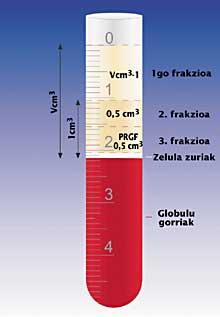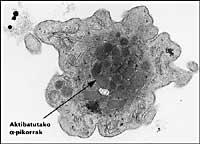Medicine from platelets
Farmazian doktorea. Biofarmazia, Farmakozinetika eta Farmazia-teknologiako irakasle kolaboratzailea
Farmazia Fakultatea UPV-EHU, Vitoria-Gasteiz

In recent years many physicists, doctors and scientists have begun to resolve these alterations. In many cases, the aim of these researchers and professionals is to improve the quality of life of patients, that is, to accelerate the recovery of patients after suffering any bone, muscle or joint injury, to recover as soon as possible the life they had.
To ensure treatment success, techniques and protocols such as new surgical techniques, more effective implant design, advances in diagnostic techniques or use of biological preparations are being tested. Among the latter highlights the availability and effectiveness of the preparation (PRGF) developed by the Biotechnology Institute (BTI) of Vitoria-Gasteiz.
This biological preparation, in addition to serving to accelerate tissue repair, can be used for tissue regeneration and tissue engineering. In addition, the preparation with blood of the receptor itself (autologous preparation) prevents rejection of the immune system. The success of PRGF lies, among other things, in its mechanism of action, which uses the same biological and cellular mechanisms involved in the body's own repairs. According to the researchers of the BTI, this preparation rich in growth factors has infinite uses and can be used not only to treat musculoskeletal disorders, but also for many other diseases.
What is PRGF?
PRGF is an autologous preparation from a platelet rich plasma. It is prepared with the blood of each patient and is rich in autologous proteins and growth factors. A peculiarity of PRGF is platelet concentration. Platelet concentration can exceed 600,000 platelets/microliters. In addition, it does not contain leukocytes or other constituents that can give immune response to other preparations contemplated in the bibliography. The main composition of PRGF are platelets, along with plasma proteins such as fibronectin and vitronectin.
To prepare PRGF it is only necessary to take a small volume of blood from a peripheral vein of the volunteer. Sodium citrate is then used as an anticoagulant. This last step is fundamental to maintaining the morphology and functionality of platelets. The use of other anticoagulants can increase platelets and lose their usual appearance, endangering the therapeutic efficacy of the preparation. The blood is then centrifuged to correctly separate all the plasma fractions. The third fraction called PRGF has a therapeutic interest and can be used for different purposes.
After many years of work, BTI researchers have understood the influence of centrifugation speed on the preparation's operation. Therefore, they perform a quiet and unique centrifugation whenever they want to prepare PRGF.
When PRGF is activated, after the addition of calcium or thrombin, the preparation produces a clot and at that time platelets are also activated. When this happens, the structure of platelets changes radically: the grains are stored in the center and emit proteins and factors. Thanks to the latter, PRGF is very effective in accelerating the recovery of certain injuries. Keep in mind that, in addition to the growth of tissues, it is essential to create blood vessels that feed them, and as already indicated, all these factors appear in the preparation.
PRGF effects in laboratory tests
The BTI has conducted several tests to determine the usefulness of the preparation rich in growth factors. For this purpose, it has developed several primary cells in the laboratory and has analyzed in detail the changes produced after the addition of PRGF. Two types of plasma were analyzed: one rich in platelets and the other not. These studies have shown that most of the factors described above are only found in platelets, but there are also some outside of them, so it is interesting to compare both plasmas.
In total, three types of cells were studied: muscle cells, tenocites and bone. Compared to inactive and low platelet plasma, the results clearly showed that activation of platelet rich plasma, and therefore, when all factors are allowed to be emitted, favors cell growth. Therefore, on the one hand, it should be noted that the activation process is essential for obtaining therapeutic effects.
However, in this study the researchers discovered that activating both types of plasma stimulated cell growth. As a result, even though platelet rich plasma produces more violent effects, the sense of all plate functions is not entirely clear.
In any case, it is clear that the therapeutic potential of platelet rich preparation is enormous. In addition to accelerating recovery from injury or alteration, it can serve to regenerate tissues. In addition, the feeling of pain is greatly reduced after the use of preparations. According to experts, the use of PRGF to treat new diseases will become widespread in the future.
Components and functioning of platelets
Having platelets as the main component of the preparation, it is interesting to analyze the components and functioning of the platelets to better understand the effectiveness of PRGF. Platelets are organelles with very important physiological functions, mainly in the repair of tissues, in homeostasis –maintaining constant the internal environment of the organism– and in the regeneration of tissues. Platelets have several granules that include growth factors and other physiological substances. For example, in dense granules there are catecholamines (serotonin and dopamine) and in granules, plasma proteins and growth factors.
It has been heavy work, but the components of this mix of factors have been characterized: Factors such as VEGF, PDGF, TGF-, bFGF, etc. have been found. The functions of these molecules are completely variable. Some are mitogens (PDGF,TGF-, etc. ), that is, they promote cell growth; others are drivers of angiogenesis (VEGF, bFGF, etc.) o inhibitors (PF4, TSP-1, etc.) are…
Bibliography
- Anitua E. and others Autologous platelets as a source of protein for healing and tissue regeneration. Thromb Haemost 91: 4-15 (2004). Anitua E. and other Autologous preparations rich in growth factors promote proliferation and induce VEGF and HGF production by human tendon cells in culture. J Orthopaedic Res (To be published).









